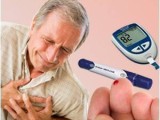Diabetic heart disease or DHD may not manifest its symptoms; those who have it may not even have the usual signs of heart disease. Known as “the silent heart disease,” DHD develops in individuals who have existing diabetic conditions.
Diabetics are generally more susceptible to acquire heart disease, may have more severe conditions of heart disease, usually develop heart conditions at a much younger age, and already have additional causes of heart disorders.
What Diabetic Cardiomyopathy Is
 Because diabetes-related damage to nerves blunts any pain in the heart, symptoms are less likely to be felt or even noticed. Diabetics should have their cardiovascular system checked regularly for detection of any possible disorders; An early treatment almost always help in the reduction or delay in what might otherwise be a serious heart condition.
Because diabetes-related damage to nerves blunts any pain in the heart, symptoms are less likely to be felt or even noticed. Diabetics should have their cardiovascular system checked regularly for detection of any possible disorders; An early treatment almost always help in the reduction or delay in what might otherwise be a serious heart condition.
A diabetic who has a heart muscle disorder is at risk for diabetic cardiomyopathy, a disease which damages the heart and its functions and leads to subsequent heart failure. Heart failure occurs when the heart’s ability to circulate blood efficiently throughout the body is impaired; with heart failure, fluid accumulates in the lungs as pulmonary edema or in the legs as peripheral edema.
Who are at Risk for DHD
Diabetic cardiomyopathy is said to be existent only if there isn’t any condition of coronary artery disease as the explanation for the disorder of the heart muscle; a majority of heart failure conditions in diabetics is actually a result of coronary artery disease.
Those with Type I and Type II diabetes are most likely to develop DHD; the higher the blood sugar level is, the greater the risk of acquiring DHD. Those with DHD are less likely to obtain success from treatments such as angioplasty or grafting in coronary artery bypass, since the presence of diabetes increases the risk of earlier or more severe heart conditions.
Those with DHD May have Heart Disease Symptoms
It is not uncommon for those afflicted with DHD to have several or most of the symptoms typically associated with heart disease. Medication prescribed for heart conditions such as angina and hypertension a.k.a. high blood pressure, for instance, includes amlodipine which is marketed as Norvasc, a calcium channel blocker that relaxes the blood vessels of the heart.
When blood vessels are relaxed, the heart doesn’t have to work as hard; blood circulation to the heart is increased, relievingpain in the chest or angina. Amlopidine, however, may have an effect on the blood glucose, or blood sugar, levels of the body.
How Amlodipine Affects Diabetics
Amlodipine may have the tendency to increase the levels of the body’s blood glucose, a condition known as hyperglycemia. The body makes glucose by breaking down simple carbohydrates, proteins, and fats; glucose is the body’s main source of fuel or energy. High levels of it, however, can inflict serious damage to the blood vessels and other body organs.
The hormone insulin, which the pancreas produces, helps in controlling those levels of blood glucose. While healthy individuals are capable of lowering their blood glucose levels if they rise from ingesting amlodipine, diabetics would have problems. Caution should be exercised in prescribing diabetics and those who have DHD with amlodipine.
Hyperglycemia Symptoms
How would you know if you are hyperglycemic? Your level of blood glucose should not be higher than the normal 160 mg/dl for you not to be classified as hyperglycemic. Amlodipine can cause hyperglycemia on a short term basis; the levels of blood glucose return to their normal condition upon discontinuance of taking amlopidine.
What symptoms point to hyperglycemia that may be caused by amlodipine? Increased hunger, blurred vision, frequent urination, increased thirst, and dryness of the mouth are some of these symptoms. It is not uncommon for diabetics to experience chronic hyperglycemia if they take amlodipine.
How Amlodipine is Administered
Amlodipine comes in oral tablet form and is taken at the same time everyday. Diabetics must check their levels of blood glucose each time before as well as after they take amlodipine.
If an individual on amlodipine exhibits hyperglycemia symptoms, he or she should report these to a doctor immediately. Any side effects which manifest should be reported to the doctor as well.
Amlodipine’s Side Effects
Patients who experience any of these symptoms while taking amlodipine should seek medical attention as soon as possible:
- Dizziness.
- Flushing,
- Excessive fatigue.
- Headache.
- Drowsiness.
- Chest pain.
- Upset stomach.
- Swelling in the lower legs, feet, hands, and ankles.
- Fainting.
- Rapid or pounding heartbeat.
- Pain spreading to the shoulders and arms.
In the early stages, symptoms of diabetic cardiomyopathy may not be detectable at once. After a while, you may experience fatigue, shortness of breath, swelling in the feet and legs, weakness, and severe cough. Note that there is not one test which can diagnose whether or not you have DHD or diabetic cardiomyopathy.
Based on symptoms, medical history, physical examination, and laboratory tests, your doctor will be able to tell you if you have DHD. Doctors, however, are still determining whether routine DHD testing can benefit those with diabetes but show no symptoms of heart disease.
Share This